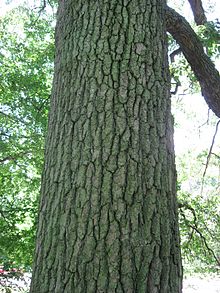Tupelo (tree)
| Tupelo | |
|---|---|

| |
| Nyssa sylvatica foliage and flowers | |
| Scientific classification | |
| Kingdom: | Plantae |
| Clade: | Tracheophytes |
| Clade: | Angiosperms |
| Clade: | Eudicots |
| Clade: | Asterids |
| Order: | Cornales |
| Family: | Nyssaceae |
| Genus: | Nyssa Gronov. ex L.[1] |
| Synonyms[2] | |
| |
Tupelo
Most Nyssa species are highly tolerant of wet
Names
The genus name Nyssa refers to a
The city of Tupelo, Mississippi, is named for this tree.
Species

Between seven and ten living species of Nyssa are recognized:[2][1]
- Nyssa aquatica L. – Water tupelo (southeastern United States)
- Nyssa biflora Walter[1][5] (or Nyssa sylvatica var. biflora[2]) – Swamp tupelo, or swamp black-gum
- Nyssa javanica (Blume) Wangerin - Eastern Himalayas, Indochina, Borneo, Java, Sumatra
- Nyssa ogeche W.Bartram ex Marshall – Ogeechee tupelo (southeastern United States)
- Nyssa sinensis Oliv. – Chinese tupelo (southern China, Vietnam, Myanmar)
- †Nyssa spatulata (Scott) Manchester[10] (Extinct, Middle Eocene; Clarno Formation, Oregon)
- Nyssa sylvatica Marshall – Black tupelo or black-gum (eastern + central United States; eastern + southern Mexico; Ontario)
- Nyssa talamancana Hammel & N.Zamora - (Panama, Costa Rica)
- †Nyssa texana Berry - (Extinct, late Eocene to early Oligocene, Whitsett and Yeuga Formations, East Texas)[11]
- Nyssa ursina
- Nyssa yunnanensis W.C.Yin – Yunnan tupelo (Yunnan)
Uses

Tupelo wood is used extensively by artistic
Tupelos are popular
Tupelos are used as food plants by the larvae of some Lepidoptera species, including Endoclita damor.[citation needed]
The Ogeechee Tupelo, sometimes referred to as the Ocheechee Lime, which is native to Georgia and north Florida produces an edible fruit in the form of a sour, oblong drupe.[17]
Honey
Tupelos of the species
The Apalachicola River in the Florida panhandle is the center for tupelo honey. The honey is produced wherever tupelo trees (three species) bloom in southeastern USA, but the purest and most expensive version (which is certified by pollen analysis) is produced in this valley. In a good harvest year, the tupelo honey crop produced by a group of specialized Florida beekeepers has a value approaching $1,000,000.[20]
Fossil record
Fruits conforming morphologically and anatomically to Nyssa have been identified from the Campanian of Alberta, Canada. The fruits conform to a kind that is common in the Paleogene, formerly called Palaeonyssa.[21]
See also
- Ulee's Gold, a film about a tupelo honey farmer
References
- ^ a b c d e "Nyssa". Germplasm Resources Information Network. Agricultural Research Service, United States Department of Agriculture. Retrieved 19 February 2016.
- ^ a b c d "Tupelo (tree)". World Checklist of Selected Plant Families (WCSP). Royal Botanic Gardens, Kew. Retrieved 20 February 2016.
- ^ Sunset Western Garden Book, 1995:606–607
- ^ a b Qin, Haining; Phengklai, Chamlong. "Nyssa". Flora of China. Vol. 13. Retrieved 19 February 2016 – via eFloras.org, Missouri Botanical Garden, St. Louis, MO & Harvard University Herbaria, Cambridge, MA.
- ^ a b "Nyssa". Integrated Taxonomic Information System. Retrieved 20 February 2016.
- ISSN 0024-4074.
- ^ "Nyssa". Gardening in the Coastal Southeast. Retrieved 21 February 2016.
- ^ Werthner, William B. (1935). Some American Trees: An intimate study of native Ohio trees. New York: The Macmillan Company. pp. xviii + 398 pp.
- ^ New Oxford American Dictionary, 2nd Edition.
- ^ Manchester, S.R. (1994). "Fruits and Seeds of the Middle Eocene Nut Beds Flora, Clarno Formation, Oregon". Palaeontographica Americana. 58: 30–31.
- ISSN 1058-5893– via University of Chicago Press journals.
- ^ Quintana, Michael G. Andreu, Melissa H. Friedman, Mary McKenzie, and Heather V. (2013-07-29). "Nyssa aquatica, Water Tupelo". edis.ifas.ufl.edu. Retrieved 2016-02-21.
{{cite web}}: CS1 maint: multiple names: authors list (link) - ^ "Black Gum and Tupelo" (PDF). Purdue Extension. Hardwood Lumber and Veneer Series. Purdue University. Retrieved 21 February 2016.
- ISBN 978-0-8018-3158-4.
- ^ Paper Trade Journal. Lockwood Trade Journal Company. 1911.
- ISBN 978-1-136-74669-7.
- ^ Boning, Charles (2006). Florida's Best Fruiting Plants: Native and Exotic Trees, Shrubs, and Vines. Sarasota, Florida: Pineapple Press, Inc. pp. 158–159.
- ^ a b "Tupelo". www.honey.com. National Honey Board. Archived from the original on March 3, 2016. Retrieved February 21, 2016.
- ^ "Liquid Gold". Garden & Gun. Retrieved 2016-02-21.
- ^ Largo, Michael (2014). The Big, Bad Book of Botany: The World's Most Fascinating Flora. HarperCollins.
- Phylogenetic Framework by Steven R. Manchester, Friðgeir Grímsson, and Reinhard Zetter, Annals of the Missouri Botanical GardenAug 2015 : Vol. 100, Issue 4, pg(s) 329-363 doi: 10.3417/2014033
External links
- USDA Plants Profile for Nyssa (tupelo)
- Page on Nyssa aquatica in America, including many photos, from Louisiana State University
